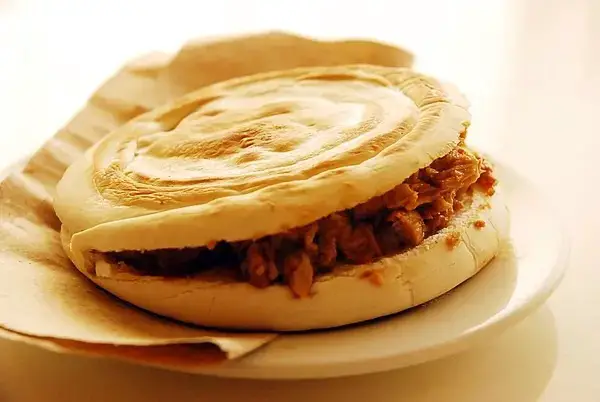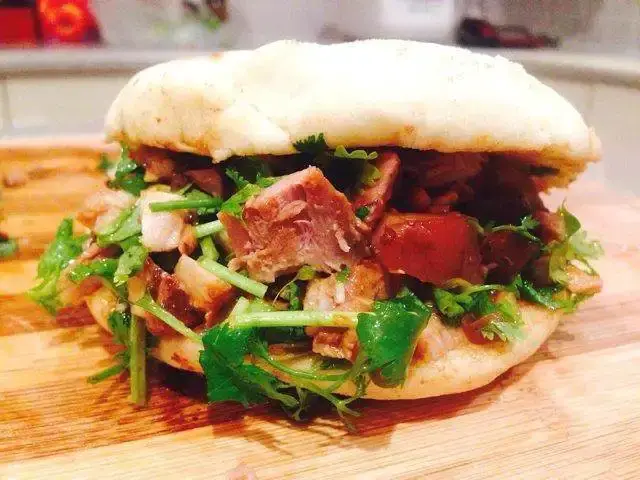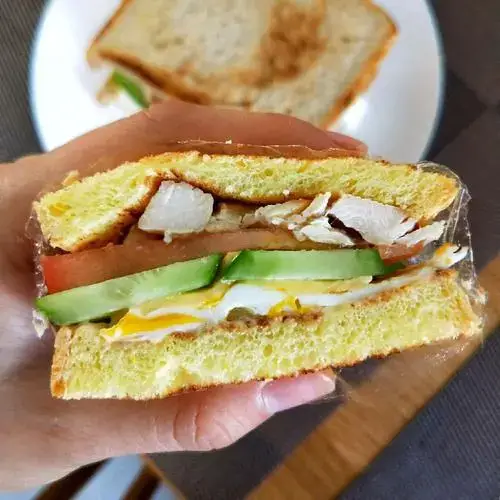Chinese cuisine is very diverse and has several culinary traditions that offer an array of foods ranging from complicated, sumptuous foods to surprisingly simple meals, such as the Rou jia mo that you can find on street corners all over China. The good news is that you do not need to wait until you travel to China or look for a Chinatown or Chinese restaurant to enjoy some of them. This is because some of the ingredients are easily available, which means that, with a little guidance, you can enjoy thousand-year-old recipes right at home.
What is rou jia mo

The popular Rou jia mo is regarded as the Chinese equivalent of hamburgers and meat sandwiches. It is a Chinese street hamburger-like food that consists of a bun that is cut open and filled with tasty, cooked meat, which makes it look somewhat like a sloppy joe or hamburger. Pork is the original and still most popular meat filling, although some variants also use beef or other kinds of meat.
Why is it called rou jia mo
The expression “Rou Jia mo” literally means “meat in a bun”. “Mo” means bun, and is the stable source of starch in the northern provinces of China, as rice is in the south. Mo baking is done in a wok or pan covered with a lid.
Rou translates to fleshy. When talking about food, it is understood to mean meat, specifically pork meat. Jia means to place the meat, hence “rou jia mo” – pork meat placed in a bun.
When was rou jia mo invented

Rou jia mo is one of the oldest types of hamburgers, with the bread or bun or “mo” being from Qin dynasty (221 BCE–206 BCE) era and the meat preparation style from Zhou dynasty (1045 BCE–256 BCE) period. However, because people have been stuffing meat inside bread for centuries, it is uncertain who did it first.
Rou jia mo history
It originated from the cuisine of Shaanxi Province and is widely eaten all over China. There is sufficient evidence to show that rou jia mo was already part of the cuisine during the Qin Dynasty (221 BC–206 BCE). According to folklore, it may have been from the earlier Warring States Period (475 BCE–221BCE) that preceded the Qin Dynasty.
However, the earliest record of these buns with meat is from the Tang Dynasty (618 CE–907 CE). It is believed that the meat sandwiches originated in the imperial palace before they became popular in Guanzhong, an area in Shaanxi province.
The earliest-known western newspaper report comparing the rou jia mo and the sandwich was in 1896 in the Chicago Daily Tribune, more than a thousand years after the Tang reports.
How to make Chinese hamburger
Since this Chinese hamburger consists of a bun and cooked meat fillings, you will need to first make each separately. The recipe below makes five of the hamburgers.
Equipment
- Wok
- Pot
- Mixing bowl
- Frying pan
- Oven
Ingredients
Ingredients for the meat filling
- 800 grams of pork belly
- 2 large onions, sliced
- 4 cloves of garlic
- 2 tablespoons light soy sauce
- 1 ½ tablespoon dark soy sauce
- 1 tablespoon Shaoxing cooking wine
- 1 tablespoon cut root ginger
- 1 tablespoon salt
- ½ cup crystal sugar
- Water or stock
Spices
- 6 cloves
- 2 star anises
- 2 bay leaves
- 1 dried chili pepper
- 1 piece of dried tangerine peel
- 1 small piece of cinnamon bark
- 1 teaspoon fennel seeds
- 1 teaspoon Sichuan peppercorn
- 1 teaspoon whole white pepper
Optional spices
- 2 pieces of dried ginger
- 1 piece of sand ginger
- 1 Fructus Amomi
- 1 nutmeg
- 1 chunk galangal
- 1 Tsaoko Amomum
- Chopped coriander
Ingredients for the Mo dough
- 200 g plain flour
- pinch of salt
- 1 tablespoon of vegetable cooking oil
- 100 ml water
- ¾ teaspoon instant yeast
Instructions
- To prepare the spices, start by soaking them in hot water for 5 minutes, then wrapping them in a bag.
- Chop the pork belly into small cubes. Put it in a wok, add a little water, ginger, cooking wine, and Sichuan peppercorn, and bring to a boil.
- Let the pork belly cubes cook for 2 to 3 minutes after boiling, then drain off the liquid.
- Braise the pork belly cubes or meat cubes in the wok by frying them on medium heat. Remove the oil and transfer the meat into a larger pot.
- In the large pot with the pork belly or meat cubes, add the spice bag, crystal sugar, ginger, green onions, light soy sauce, salt, and dark soy sauce. Add enough water to cover the pork belly.
- Bring all the contents to a boil and then simmer for about an hour. Let the meat sit in the soup until you are ready to use it on the bun.
- To make the bun, start by mixing the yeast in the water and letting it set for about 5 minutes.
- In a bowl, add the salt and oil to the flour and pour in the yeast-water mix. Knead the dough until it is smooth. Cover it with a wet cloth and let it rest for around 15 to 30 minutes, or until the dough rises and gets to about 13 of its original size.
- Knead the dough to remove the air. Remove and roll it into a log, then divide it into 5 equal portions.
- Roll each portion into a long log with two small ends. Wrap the log around itself, from one end to the other, tucking in the other end to form a flattened ball shape. Slowly press it to flatten it down, turn it over, and roll it out until you get a 1.5 cm thick flat dough bowl.
- Heat up the pan. Place the shaped dough in the fryer until it begins to brown slightly, then flip it over and repeat the process. Use low-heat fire.
- Repeat the process for all the dough bowls/buns, then preheat the oven to 190 °C/375 °F/gas mark 5. Place the buns on a baking sheet and put them in the oven. Bake for about 10 minutes so that the buns are completely cooked through.
- To assemble the bun, reheat the meat in the pot, remove the meat, and mince it. At this point, you can add the optional cumin powder and chopped coriander.
- Cut open the bun 2/3 of the way along the middle on the narrow edge. Place the cooked meat or pork inside the bun with the other ingredients, serve warm, and enjoy.
Roujiamo vs Hamburger
Among the many sandwich-like dishes from around the world, two that stand out are the Chinese roujiamo and the American hamburger. While they do have some commonalities, such as ingredients and methods of preparation, there are also notable distinctions that set each apart and contribute to their unique cultural significance.
Traditional roujiamo hails from China’s Shaanxi province and is eaten as a street snack throughout the region. Wheat flour is used to make a flatbread that is stuffed with pork or beef that has been spiced and complemented by a variety of vegetables. In order to achieve a fork-tender consistency, the meat is typically stewed for several hours, and the flatbread is typically toasted on a griddle before being served. The aromatic and flavorful filling of a roujiamo is what makes it so popular.
In contrast, the hamburger is an American invention that has become a fast food staple around the world. A hamburger is a sandwich made from a ground beef patty that has been cooked on a grill or griddle and topped with condiments like ketchup, mustard, or mayonnaise, as well as other ingredients like lettuce, tomato, onion, and cheese. The patty of the burger is crisp on the outside and tender and juicy in the middle.
The “Chinese hamburger,” or roujiamo, is a staple of Shaanxi cuisine and carries significant cultural weight. It has been around since the Qin Dynasty and is now a common street food in Xi’an and other nearby cities. On the other hand, the hamburger is a worldwide phenomenon that has come to represent America and its culture.
The main filling in roujiamo is spiced meat and vegetables, while the main filling in a hamburger is typically a beef patty, with additional toppings. Traditionally, roujiamo is served on a flatbread, while burger buns are made from wheat flour and topped with sesame seeds.

Roujiamo vs Sandwich
Similar to the popular sandwich, roujiamo is made by sandwiching filling between two slices of bread. Although they share a common cultural significance, they vary in terms of ingredients, preparation, and even name.
Roujiamo, which originated in the Chinese province of Shaanxi, is a popular and well-known Chinese snack. You’ll find pork or beef that’s been spiced along with peppers, onions, lettuce, and other vegetables stuffed into a flatbread made from wheat flour. In order to achieve a fork-tender consistency, the meat is typically stewed for several hours, and the flatbread is typically toasted on a griddle before being served. The aromatic and flavorful filling of a roujiamo is what makes it so popular.
The sandwich, on the other hand, is a globally distributed food staple. Sandwiches are made by placing meat, cheese, vegetables, or other fillings in between two slices of bread. Sliced bread, bagels, croissants, and pita bread are just some of the bread options that can be used to make a sandwich. The condiments, which may include mustard, mayonnaise, or ketchup, can be grilled, roasted, or served cold.
The “Chinese hamburger,” or roujiamo, is a staple of Shaanxi cuisine and carries significant cultural weight. It has been around since the Qin Dynasty and is now a common street food in Xi’an and other nearby cities. But sandwiches are a worldwide favorite and are frequently associated with fast food and the pursuit of convenience.
The main filling of a roujiamo is typically spiced meat and vegetables, while sandwiches can have a wide variety of fillings due to regional and cultural differences. You can put anything in a sandwich, from meat to cheese to vegetables to eggs to fish to fruit.

Conclusion
Although there is a debate on where the idea originated, there is strong evidence that hamburgers as we know them originated from the rou jia mo. What is not debatable is the fact that people, both in the East and the West, enjoy eating meat sandwiched between buns, regardless of where the idea originated from.